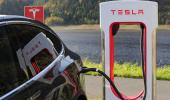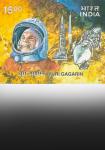The only silver lining in March's performance -- which otherwise dragged down the financial year's momentum -- was a 6 per cent year-on-year (Y-o-Y) growth compared to March of the previous year. This is largely due to incentives, festival-driven gains, and new launches.

Automobile retail sales grew 6.5 per cent in financial year 2024–25 (FY25), driven primarily by a 5 per cent rise in passenger vehicle (PV) sales, an 8 per cent increase in two-wheeler numbers, and a 5 per cent uptick in commercial vehicle (CV) sales.
This compares to a growth of 10 per cent for the industry in the previous financial year (FY24).
However, concerns emerged in March, as retail sales declined for the second consecutive month -- down 0.7 per cent compared to March 2024.
The fall was attributed to a 2 per cent slide in two-wheeler sales, a 6 per cent drop in three-wheeler sales, and a 6 per cent decline in tractor sales, according to data from the Federation of Automobile Dealers Associations (Fada).
The only silver lining in March's performance -- which otherwise dragged down the financial year's momentum -- was a 6 per cent year-on-year (Y-o-Y) growth compared to March of the previous year. This is largely due to incentives, festival-driven gains, and new launches.
In February, industry sales were down by 7 per cent, with all categories falling into the red.
In absolute numbers, the country saw sales of 26 million vehicles in FY25, versus 24.5 million in FY24.
"The first three weeks of March were notably weak, largely due to the Kharmas period, but sales accelerated significantly last week, driven by positive triggers such as Navratri, Gudi Padwa, Eid, and year-end purchasing influenced by depreciation benefits," said C S Vigneshwar, president, Fada.
Though passenger vehicles posted a good show in March, the dealers' body warned original equipment manufacturers (OEMs) about a higher inventory level of 50–55 days.
"Unrealistic targets, liquidity challenges, and regional pockets of low demand are resulting in PV inventories rising to about 50–55 days. Incentives and festival-driven gains pushed overall results higher, but dealers remain cautious about high-stock levels and target pressures as the new financial year begins," Vigneshwar added.
Dealers across India are cautiously optimistic, looking ahead to FY26, with Fada projecting mid-to-high single-digit growth in the two-wheeler segment and low single-digit growth for both PVs and CVs.
Another cause for concern for the government and the industry is the static growth in the penetration level of electric vehicles (EVs).
While EV penetration moved marginally up from 7.1 per cent in FY24 to 7.8 per cent in 2025, in March 2025 it came down to 9.9 per cent compared to 10.3 per cent last March.
In PVs, market leader Maruti Suzuki posted a 3 per cent rise in sales in March to 132,423 units.
However, a healthy competition is going on between three majors -- Tata Motors, Mahindra and Mahindra (M&M), and Hyundai Motor -- for the second slot.
In February, M&M had unseated Hyundai Motor to become the number two player in the market, while in March it was Tata Motors' turn, which clocked sales of 48,462 units, up 4 per cent compared to the same period last year.
M&M saw sales go up by 17 per cent to 46,297 units in March versus last year, while Hyundai Motor was hit in the number two race with sales of 42,511 units, down 5 per cent.
CV dealerships reported moderate 2.68 per cent Y-o-Y growth, due to Gudi Padwa deliveries, supportive financing, and infrastructure activity that elevated customer footfall.
However, major hurdles for the segment included aggressive targets and uneven product availability, Fada added.
JLR's North America wholesale volumes up in Q4 ahead of Trump's tariffs
-Sohini Das
Jaguar Land Rover (JLR) posted flat wholesale and retail volumes for the full financial year 2024-25 (FY25) at 400,898 units and 428,854 units respectively.
In the fourth quarter, the retail sales slipped 5.1 per cent to 108,232 units even as wholesales were up marginally by 1.1 per cent to 111,413 units.
Interestingly, the wholesale volumes were up 14.4 per cent in North America for the fourth quarter. JLR has paused shipments to the US in April after President Donald Trump declared a 25 per cent tariff on automobile imports. The company does not have a plant in the US and exports cars to that country from the UK and Slovakia plants.
US is JLR's most important market, accounting for roughly a quarter of its sales.
Tata Motors stock had a tough day on the bourses, ending the day's trade at Rs 579.85, down 5.5 per cent.
China continues to remain a pain-point in JLR's global sales.
In Q4FY25, Chinese wholesale volumes fell by 29.4 per cent, even as North America grew by 14.4 per cent, Europe by 10.9 per cent, and the UK remained flat at 0.8 per cent. Excluding the Chery Jaguar Land Rover China joint venture, the wholesale volumes (111,413 units) was up 6.7 per cent, compared to the previous quarter (Q3FY25), and up 1.1 per cent year-on-year.
The US tariffs come at a time when JLR is facing challenges in China. "China continues to remain under stress. However, JLR remains the least impacted with a decline of just 3 per cent, compared to the industry's decline of over 20 per cent. Its inventory in China is also well under control," Motilal Oswal analysts had said in a note last month.
The mix of Range Rover, Range Rover Sport and Defender in FY25 was 67.8 per cent of total wholesales.
Retail sales for the fourth quarter of 108,232 units (including the Chery Jaguar Land Rover China JV) were down 5.1 per cent, compared to Q4FY24 and up 1.8 per cent compared to Q3FY25.
In addition, JLR achieved its net debt zero target, ending the financial year net cash positive.












 © 2025
© 2025